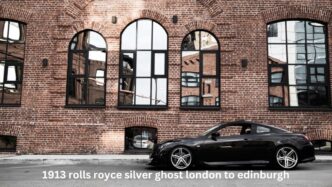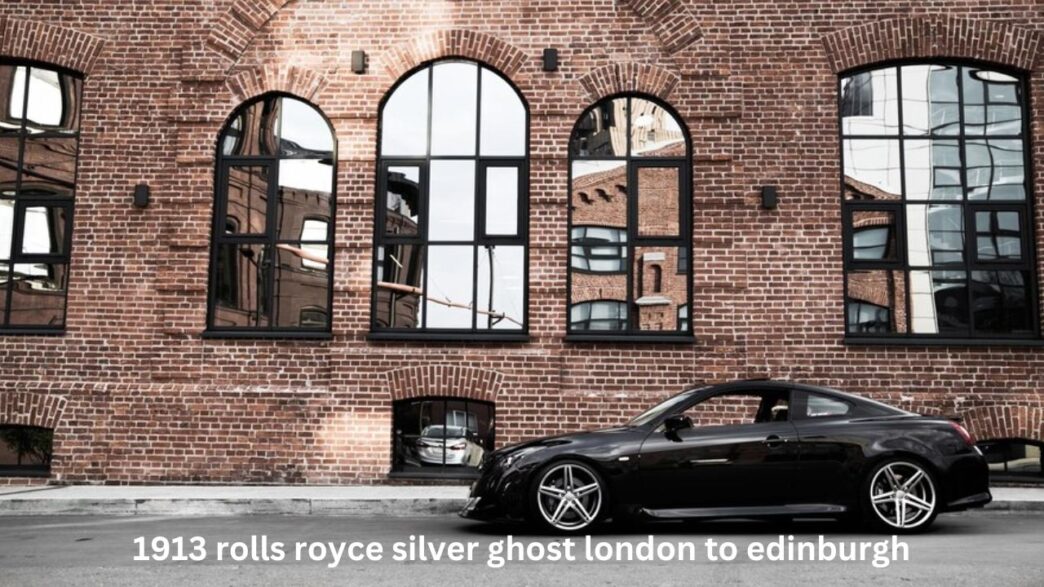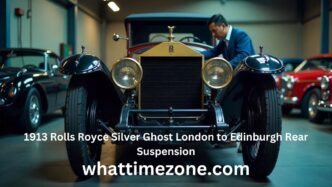The 1913 Rolls Royce Silver Ghost London to Edinburgh stands as a legendary model that redefined luxury, performance, and engineering excellence. This specific variant of the Silver Ghost rose to fame after its impressive endurance run from London to Edinburgh and back, which showcased its power, reliability, and efficiency. Rolls Royce’s commitment to setting new standards in motoring made the London to Edinburgh edition a significant chapter in the brand’s storied history.
In this article, we explore the history, design, and performance of the 1913 Rolls Royce Silver Ghost London to Edinburgh. We’ll also highlight how this model demonstrated unrivaled engineering capabilities and laid the foundation for the brand’s reputation as the “Best Car in the World.”
The Origins of the Rolls Royce Silver Ghost
Introduced in 1906, the Rolls Royce Silver Ghost was developed to replace the earlier 40/50 hp model. With its stunning design, advanced engineering, and impeccable craftsmanship, the Silver Ghost quickly earned a reputation for being one of the finest cars ever built. It became a symbol of luxury, reliability, and innovation in the early 20th century.
By 1913, the Silver Ghost had undergone several refinements. Rolls Royce was determined to prove the car’s superiority, which led to the creation of the “London to Edinburgh” edition. This special model was built to perform exceptionally well during endurance runs and to demonstrate remarkable fuel efficiency.
The London to Edinburgh Challenge: A Test of Endurance
The idea for the London to Edinburgh challenge originated in 1911, when Rolls Royce sought to prove the capabilities of their vehicles under demanding conditions. The challenge involved driving the Silver Ghost from London to Edinburgh and back, covering over 800 miles on difficult roads. The route tested the car’s speed, durability, and fuel efficiency.
During this iconic journey, a specially tuned Silver Ghost completed the entire route in top gear. Despite the steep inclines and rugged terrain, the car maintained an impressive average speed and consumed remarkably little fuel. This achievement cemented the Silver Ghost’s reputation as an engineering marvel.
In 1913, Rolls Royce released a limited-edition “London to Edinburgh” variant to commemorate this historic achievement. The 1913 Rolls Royce Silver Ghost London to Edinburgh edition became a collector’s dream and a symbol of the brand’s excellence.
What Makes the 1913 Rolls Royce Silver Ghost London to Edinburgh Unique?
Several design and mechanical enhancements distinguished the 1913 Rolls Royce Silver Ghost London to Edinburgh from the standard models. These upgrades were specifically intended to improve performance and fuel efficiency.
1. High-Compression Engine
The London to Edinburgh edition featured a high-compression engine, which increased power output and improved fuel efficiency. This engine enabled the car to perform exceptionally well on long-distance journeys.
2. Lightweight Construction
Engineers reduced the car’s weight by incorporating lightweight materials, including an aluminum body. This weight reduction contributed to better handling, improved speed, and enhanced fuel economy.
3. Streamlined Design
The car’s design featured a slightly streamlined body that reduced air resistance. This aerodynamic improvement helped the Silver Ghost achieve higher speeds with greater efficiency.
4. Enhanced Gear Ratios
A higher rear axle ratio allowed the car to sustain high speeds while maintaining smoothness and reliability. This feature made it possible for the vehicle to complete the London to Edinburgh route entirely in top gear.
5. Luxurious Interiors
Despite its performance-focused upgrades, the 1913 London to Edinburgh edition retained Rolls Royce’s commitment to luxury. The car featured plush leather seats, handcrafted wood trims, and meticulous attention to detail, ensuring unparalleled comfort for passengers.
These unique features demonstrated Rolls Royce’s ability to blend performance with luxury seamlessly.
The Endurance Run and Its Impact
The endurance run from London to Edinburgh was more than just a test of the Silver Ghost’s capabilities. It was also a brilliant marketing move that showcased the car’s superiority in a competitive automotive market. During the run, the Silver Ghost achieved an average fuel consumption of 24 miles per gallon, which was considered remarkable for its time.
This achievement not only impressed consumers but also set Rolls Royce apart from its competitors. The endurance run highlighted the brand’s engineering excellence and reinforced its reputation as a leader in the luxury car segment.
Legacy of the 1913 Rolls Royce Silver Ghost London to Edinburgh
The 1913 Rolls Royce Silver Ghost London to Edinburgh edition holds a special place in automotive history. Its success demonstrated the brand’s ability to create vehicles that combined performance, luxury, and reliability. Here are some ways this model influenced the industry:
- Benchmark for Engineering Excellence: The car set new standards for durability, fuel efficiency, and performance, inspiring other manufacturers to raise their standards.
- Advancement of Automotive Design: Features like lightweight construction and streamlined design paved the way for modern automotive engineering.
- Establishment of Rolls Royce’s Reputation: The success of the London to Edinburgh model solidified Rolls Royce’s status as a luxury carmaker par excellence.
- Collector’s Item: The limited production of the 1913 edition has made it one of the most sought-after vintage cars among collectors and enthusiasts.
The legacy of the London to Edinburgh edition continues to inspire admiration and respect within the automotive community.
Restoration and Preservation of the 1913 Rolls Royce Silver Ghost
Preserving a historic vehicle like the 1913 Rolls Royce Silver Ghost London to Edinburgh requires meticulous attention to detail. Owners and collectors often invest significant time and resources into restoring these cars to their original condition. Restoration efforts focus on maintaining authenticity while ensuring the car remains functional.
Key aspects of restoration include:
- Engine Rebuilds: Rebuilding the high-compression engine to factory specifications.
- Bodywork Repairs: Restoring the aluminum body and retaining its lightweight structure.
- Interior Refinements: Reupholstering leather seats and restoring wood trims to their original elegance.
- Mechanical Upgrades: Updating parts like brakes and suspension to enhance safety without compromising authenticity.
Restored models of the 1913 Rolls Royce Silver Ghost London to Edinburgh frequently appear at classic car shows and auctions, where they attract significant attention and high bids.
Why the 1913 London to Edinburgh Edition Remains Relevant Today
Even over a century later, the 1913 Rolls Royce Silver Ghost London to Edinburgh continues to captivate car enthusiasts and historians alike. Its relevance lies in the timeless principles it embodies:
- Engineering Innovation: The car represents the ingenuity and precision of early automotive engineering.
- Luxury Redefined: Its blend of opulence and functionality set a standard that modern luxury cars still strive to match.
- Historical Significance: The endurance run is a reminder of the automotive industry’s evolution and the pioneering spirit of early manufacturers.
- Inspiration for Modern Cars: Elements of the Silver Ghost’s design and mechanics have influenced the development of contemporary vehicles.
By studying the London to Edinburgh edition, one gains valuable insights into the history and progression of the automotive world.
Frequently Asked Questions
What is the significance of the 1913 Rolls Royce Silver Ghost London to Edinburgh edition?
This model demonstrated exceptional performance, fuel efficiency, and durability during the London to Edinburgh endurance run.
How was the London to Edinburgh edition different from standard Silver Ghost models?
It featured a high-compression engine, lightweight construction, streamlined design, and enhanced gear ratios for improved performance.
What made the endurance run iconic?
The endurance run showcased the Silver Ghost’s ability to complete 800 miles in top gear while achieving remarkable fuel efficiency.
Why is the 1913 Silver Ghost considered a collector’s item?
Its limited production, historical significance, and groundbreaking features make it highly sought after among vintage car enthusiasts.
How does the 1913 edition influence modern car design?
Its lightweight materials, aerodynamic improvements, and focus on reliability inspired advancements in automotive engineering.
What challenges arise during the restoration of this model?
Restoring its high-compression engine, lightweight aluminum body, and luxurious interiors requires expertise and access to original parts.
Conclusion
The 1913 Rolls Royce Silver Ghost London to Edinburgh stands as a testament to the brand’s commitment to excellence, innovation, and luxury. Its legendary endurance run highlighted the car’s remarkable capabilities and reinforced Rolls Royce’s reputation as the “Best Car in the World.”
This iconic model not only influenced the development of luxury automobiles but also left an indelible mark on automotive history. By preserving and celebrating the London to Edinburgh edition, enthusiasts ensure that its legacy continues to inspire future generations.






